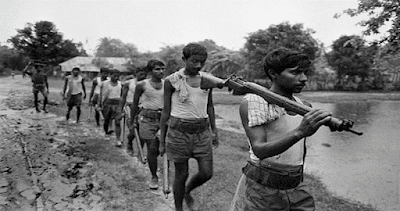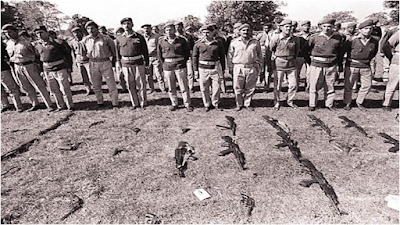On December 16, 1971, Lt Gen Amir Abdullah Khan Niazi, the Chief Martial Law Administrator of East Pakistan and Commander of Pakistan Army forces located in East Pakistan signed the Instrument of Surrender. Over 93,000 Pakistani troops surrendered to the Indian forces and Bangladesh Liberation forces making it the largest surrender since World War II.
The
war and its result had different impacts on the three nations involved: The
victory defined India's much broader role in foreign politics. Many countries
in the world, including the United States, realised that the balance of power
had shifted to India in South Asia. Bangladesh became an independent country
and Pakistan was shattered economically and politically. India and Bangladesh
embarked on a strong bond of friendship and mutual respect by this action.
The Liberation War of Bangladesh:
Role of the Army
Liberation
War of Bangladesh is indeed a unique episode of her history. During the
Liberation War, the Bengali Army formed the Mukti Fouz and played innumerable
role as the nucleus of Mukti Bahini. The Bengali army conducted operations in
their respective domains against the Pakistani forces from March 26, 1971. On 4
April 1971, they formed Mukti Fouz under the command of M A G Osmani without
any central political direction. After forming Government-in-Exile, Bangladesh
army fought under 7 regional commands till 11 July. Then Bangladesh Army fought
for the country under 11 sectors from July to December 16 according to “ Teliapara
Strategy”.
TELIAPARA STRATEGY
The
fighting tactics were mostly in the form of commando operations such as
ambushes, demolitions and liquidation of collaborators. The “Teliapara
Strategy” consisted of three important fighting tactics
1)
Reliance on guerrilla with a view to liquidating the collaborators of the
Pakistan army.
2)
Destroying the communication links to immobilize the enemy forces.
3)
Engaging the “hit and run” operations against the enemy supply lines to make
them anxious and scared.
WHY DID
PAKISTAN SURRENDER IN 1971?
Faced
with insurmountable losses, the Pakistani military capitulated in less than a
fortnight and psychological panic spread in the Eastern Command’s military
leadership.
Subsequently,
the Indian Army encircled Dacca and issued an ultimatum to surrender in
“30-minutes” time window on 16 December 1971.
INDO-PAKISTAN
WAR OF 1971
The
Indo-Pakistan War of 1971 was a military confrontation between India and
Pakistan that occurred during the Bangladesh Liberation War in East Pakistan
from 3 December 1971 to the fall of Dacca(Dhaka) on 16 December 1971.The war
began with “Operation Chengiz Khan’s” preemptive aerial strikes on 11 Indian
air stations,which led to the commencement of hostilities with Pakistan and
Indian entry into the war for independence in East Pakistan on the side of
“Mukti Bahini”.13 days after the Indo-Pakistan War started,the Eastern Command
of the Pakistan army signed the “Instrument of Surrender” on 16 December 1971
in Dhaka, marking the formation of East Pakistan as the new nation of
Bangladesh.
OPERATION
KILO FLIGHT
Kilo
Flight is the
code name for the Mukti Bahini combat aviation formation during
the Bangladesh Liberation War in 1971. It consisted of one DHC-3
Otter plane and one Alouette III helicopter, both carrying
rocket pods and machine guns for launching hit-and-run attacks on Pakistani
targets. The aircraft were supplied by Indian Authorities and the
formation was led by Squadron Leader Sultan Mahmud. this unit was the
first to launch airstrikes on Pakistani targets in East Pakistan on
December 4, 1971, by attacking oil depots
at Narayanganj and Chittagong.
BATTLE
OF GAZIPUR
The Battle
of Gazipur was a military engagement on 4 and 5 December 1971, during
the Bangladesh liberation war. It took place at the Gazipur Tea Estate
near Kulaura, in the Sylhet District of what was then East
Pakistan. The advancing Mitro Bahini (comprising Mukti
Bahini and Indian Army) attacked the 22 Baluch Regiment of
the Pakistan Army. This battle was a prelude to the Battle of Sylhet.
BATTLE OF JESSORE
Under
the liberation war sector no 8, fighters coming from all strata of life fought
heroically under their commander Major MA Manzur in the frontline and freed the
district from the clutches of the Pakistan occupation army without any
resistance on December 6. India acknowledges Bangladesh as a free and sovereign
state. Muktibahini take firm positions at Laksham, Akhaura, Chouddagram and
Hili.
BATTLE OF SYLHET
The Battle
of Sylhet was a major battle fought between the advancing Mitro Bahini and the Pakistani defences
at Sylhet during the Bangladesh Liberation War.On 7th December
the Pakistanis had evacuated the civilian population from Sylhet and fortified
the town.From 9th December onwards the Sylhet garrison of two
brigades strength remained surrounded and isolated from the rest of the sector
until it finally surrounded on 17th December.
OPERATION
CACTUS LILLY
TANGAIL
AIRDROP
The Tangail
Airdrop was a successful battalion-size Para Commandos
(India) operation mounted on 11 December 1971 by the 2nd Battalion
(Special Operations) of the Indian Army's Parachute
Regiment during the Indo-Pakistani War of 1971 for
the liberation of Bangladesh. The main objective of the operation was the
capture of Poongli Bridge on the Jamuna River which would cut
off the Pakistani 93rd Brigade which was retreating
from Mymensingh in the north to defend the capital of East Pakistan, Dacca,
and its approaches.
KILLING
OF BENGALI INTELLECTUAL
In
1971, the Pakistan Army and their local collaborators, most notably the
extreme right wing Islamist militia group Al-Badr, engaged in
the systematic execution of Bengali pro-liberation intellectuals
during the Bangladesh Liberation War of 1971, a war crime. Intellectuals
were killed throughout the entire duration of the war. 14 December is
commemorated in Bangladesh as Martyred Intellectuals Day.
Role of Mukti Bahini in Liberation
War of Bangladesh
The Bangladeshi Declaration of Independence was proclaimed from Chittagong by members of the Mukti Bahini—the national liberation army formed by Bengali military, paramilitary and civilians. The East Bengal Regiment and the East Pakistan Rifles played a crucial role in the resistance. Led by General M. A. G. Osmani and eleven sector commanders, the Bangladesh Forces waged a mass guerilla war against the Pakistani military. They liberated numerous towns and cities in the initial months of the conflict.
Conditons Proposed by Niaz to
United State Consul General for Surrender
Cease fire
and stop all hostilities immediately in East Pakistan.
Hand over
peacefully the administration of East Pakistan as arranged by the UN.
The UN
should ensure:
1) Safety
and security of all Armed Forces personnel of both military and para-military
forces of Pakistan pending their return to West Pakistan.
2) Safety
of all West Pakistan, civilians and civil servants, pending their return to
west Pakistan.
3) Safety
of non-locals settled in east Pakistan since 1947.
4) Guarantee
of no reprisal against those who helped and served the government and the cause
of Pakistan since 1947.
Surrender of Pakistan Eastern Army to
East Pakistan
Officially,
the Instrument of Surrender of Pakistan Eastern Command stationed in East
Pakistan, was signed between the Lieutenant General Jagjit Singh Aurora, the
GOC-in-C of Indian Eastern Command and Lieutenant-General A.A.K. Niazi, the
Commander of the Pakistan Eastern Command, at the Ramna Race Course in
Dacca on 16 December 1971. As the surrender was accepted
silently by Lieutenant-General Aurora, the surrounding crowds on the race
course started shouting anti-Pakistan slogans.
VICTORY
DAY
December
16,1971 the day when Pakistan’s armed forces laid down their arms at a
surrender ceremony in Dhaka before the joint command of the Indian armed forces
and Bangladesh’s Mukti Bahini, was the finest hour in both India and
Bangladesh’s military histories. The Pakistani Instrument of Surrender was a
written agreement that enabled the surrender of 93000 soldiers of the Pakistan
Armed Forces Eastern Command on 16 December 1971, thereby ending the Bangladesh
Liberation War and the creation of the nation of Bangladesh. The day is
commemorated as Victory Day, a national holiday in Bangladesh
REACTION IN WEST PAKISTAN TO THE
WAR
Reaction
to the defeat and dismemberment of half the nation was a shocking loss to top
military and civilians alike. Few had expected that they would lose the formal
war in under a fortnight, and there was also unsettlement over what was
perceived as a meek surrender of the army in East Pakistan. Yahya Khan's
dictatorship collapsed and gave way to Bhutto, who took the opportunity to rise
to power. General Niazi, who surrendered along with 93,000 troops, was
viewed with suspicion and contempt upon his return to Pakistan. He was shunned
and branded a traitor.








